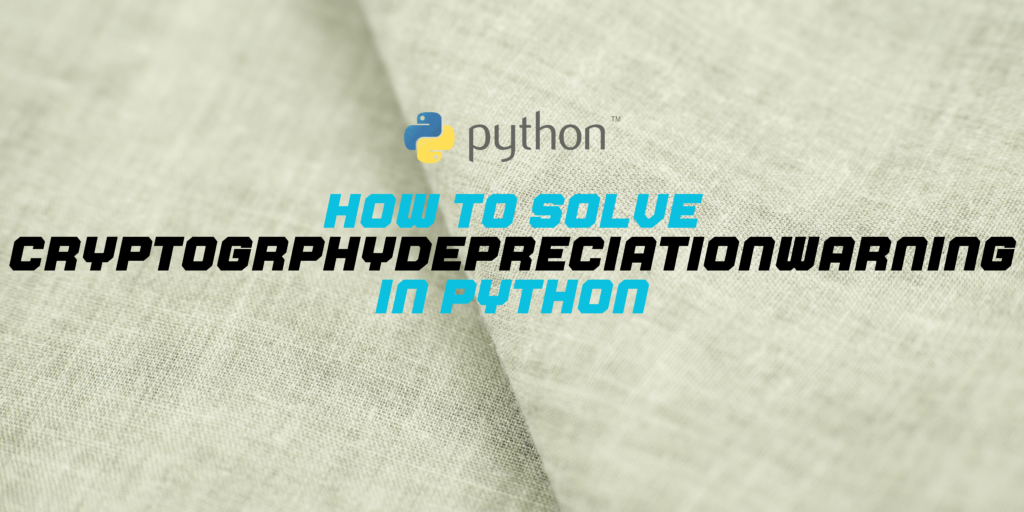As with any software or programming language, they evolve and the older versions reach the end of their support life cycle.
The developer team no longer wants to update older versions when newer ones appear. The team only wants to keep the newer versions up-to-date so that they can support other applications and focus on patching bugs and security concerns. One such concern is the CryptographyDeprecationWarning: which signals the deprecation of outdated cryptographic standards.
In this article, we will learn what this warning is and understand its causes, implications and solutions.
The CryptographyDeprecationWarning in Python 3.6 indicates that the version is no longer supported and is vulnerable to security threats. To resolve this issue, you can either install the latest Python version, use a virtual environment to isolate your project, or update your cryptographic dependencies. Failure to address this warning can lead to security mishaps and non-compliance with data privacy regulations. By taking the necessary steps, you can ensure the security and integrity of your Python environment.
What is the CryptographyDeprecationWarning?
In the context of Python, the CryptographyDeprecationWarning is issued to notify users about the depreciated cryptographic features or standards. When this happens for your Python 3.6 version, it is trying to tell you that this version is no longer receiving updates. This includes security patches, support and cryptographic improvements.
This means that your Python environment is now vulnerable to security threats, which makes it more susceptible to attacks. Ignoring this warning can be detrimental to applications that depend on cryptographic operations.
Some security mishaps that can occur due to outdated Python versions are: unauthorized access, data inception and tampering.
Compliance standards such as GDPR, HIPAA and PCI DSS make it mandatory to use up-to-date software for data security and privacy. Failure to comply with these regulations might lead to legal consequences for organizations and ruin their reputations.
Solutions for Resolving the CryptographyDeprecationWarning
There is more than one way to solve this problem but it isn’t a very difficult task even for beginners. In this section, we will explore some methods to solve this problem one by one. We will explore three main techniques: installing the latest python version, using a virtual environment and upgrading our cryptography.
Solution 1: Installing the Latest Python Version
You can install the latest Python version by downloading it here for your respective system, be it macOS, windows, or Linux. Then you can check the python version using the system or the sys module.
The sys.version function displays your system’s Python version.
import sys
print(sys.version)
Your output should be as follows:
Python 3.10.12
This is the most straightforward solution to this problem. This ensures that your python environment is 3.7 or higher with improved cryptographic security and support for modern cryptographic algorithms. This ensures that your system is up-to-date and is compliant with current standards.
Solution 2: Using Virtual Environments
For projects that are constrained by dependencies and require specific versions of Python, updating cryptographies might led to obsolete codes and problems in application management. Tools like conda and virtualenv allow users to create isolated projects by keeping specific versions with specific packages. This mitigates the risk of compatibility issues or security vulnerabilities.
If you don’t have virtualenv in your system, you can install it by running the following code:
pip3 install virtualenv
You can create a virtualenv by following the code given below:
# Creating a virtual environment using venv
virtualenv venv
# Activating the virtual environment
# On Windows:
venv\Scripts\activate
# On Unix or MacOS:
source venv/bin/activate
# Now, your Python environment is isolated within the virtual environment
# Installing required packages and dependencies within this environment
# For example:
# pip install <package_name>
Suggested: Easy Introduction to Cryptography in Python.
Solution 3: Updating Cryptographic Dependencies
Developers can update specific cryptographic dependencies such OpenSSL which are regularly updated to patch vulnerabilities and maintain compatibility with current standards. Additionally, monitoring security advisories and subscribing to relevant channels can help you stay updated with critical updates and patches.
You can update cryptography by running the following code in your command prompt:
pip3 install --upgrade cryptography
If all your cryptography is updated, you will get a message like this:

Requirement already satisfied: cryptography in /usr/local/lib/python3.10/dist-packages (42.0.5)
Requirement already satisfied: cffi>=1.12 in /usr/local/lib/python3.10/dist-packages (from cryptography) (1.16.0)
Requirement already satisfied: pycparser in /usr/local/lib/python3.10/dist-packages (from cffi>=1.12->cryptography) (2.21)
Recommended: RSA Algorithm: Theory and Implementation in Python
Summary
When you come across the CryptographyDeprecationWarning in Python 3.6, it’s like a friendly nudge telling you, “Hey, it’s time to up your security game!” You see, Python 3.6 is getting a bit long in the tooth, and it’s no longer receiving those important security updates and fancy new cryptographic features.
Now, you might be tempted to sweep this warning under the rug and continue your day. But trust me, that’s not the best idea. Your system becomes an easy target for all sorts of security shenanigans. Before you know it, you’re dealing with data breaches, compliance headaches, and a whole lot of explaining to do.
So don’t skip the warning sign; instead, take security best practices head-on.
